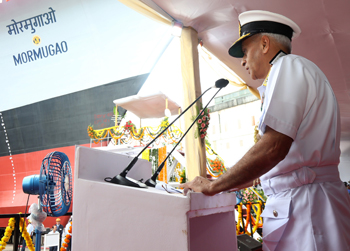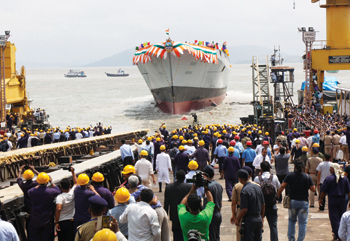INDIAN ARMED FORCES CHIEFS ON
OUR RELENTLESS AND FOCUSED PUBLISHING EFFORTS

SP Guide Publications puts forth a well compiled articulation of issues, pursuits and accomplishments of the Indian Army, over the years

I am confident that SP Guide Publications would continue to inform, inspire and influence.

My compliments to SP Guide Publications for informative and credible reportage on contemporary aerospace issues over the past six decades.
Lead Story
Project 15B – Multi-Mission Destroyers on the Roll
If the professed construction and fitting out schedules of Project 15B are adhered to, it will be vying with the most exacting and efficient warship building standards practised by the leading US and European shipbuilders

Soon after the acquisition of Soviet origin guided missile destroyers, Indian Navy’s Naval Design Bureau decided to expand their own indigenous stable inventory to include design of guided missile destroyers. The result was successful evolution of Project 15 Destroyers, which later came to be known as the Delhi class. While the indigenous project design had both Soviet and Western design influences, naval designers came up with a marvel of ab initio design of a guided missile destroyer. Thus from the Stable of Project 15; Indian Navy ships Delhi, Mysore and Mumbai were born which now occupy the ‘Frontline Ships’ status of the Indian Navy. The efficacy of the design of Project 15 was substantially established when INS Delhi withstood the severest of cyclonic conditions when trapped for 48 hours in the South China Sea and successfully came out of it without any damage to the structure and the systems.
The Indian Naval Design Bureau was not resting on their oars and soon launched the first follow-on project which was designated as Project 15A. This project imbibed not just the technology updates in its design it also factored in all the right lessons learnt from its predecessor Project 15, to be launched with far greater efficiency and efficacy. The result was successful commissioning of Indian Navy ships Kolkata, Kochi and Chennai. These stealth destroyers occupy the pride of place in the Frontlines with plethora of top-end technology systems, equipment and arsenal. Another unique feature of Project 15A was replacement of all major Russian origin systems with either the indigenous systems or those acquired from the West through arrangements of transfer of technology.
Taking a long-term perspective of the Indian Navy’s capability build up to be the net maritime security provider of the nation, reviews of the existing designs of the ships for upgrades to include emerging technologies and design features, as also to add designs of the newer classes of platform are the main focus areas of the Directorate General of Naval Design (DGND). Project 15B has thus emerged as the latest class of stealth guided missile destroyers. By increasing the cavitation inception speed the hydrodynamic noises and vibrations have been effectively reduced at the cruising speed in each of the ships of Project 15B.
Project 15B
The first ship of Project 15B guided missile destroyer was christened as Visakhapatnam and launched on April 20, 2015, at Mazagon Dock Limited (MDL) in Mumbai by Mrs Minu Dhowan, wife of Admiral R.K. Dhowan, former Chief of the Naval Staff.
Visakhapatnam is the first of the line of four destroyers of the class designed by the Directorate of Naval Design and bear the testimony to the acclaimed legacy of the naval designers. The ship is being built by MDL, the acclaimed warship builders of the nation. Each stealth destroyers of Project 15B has a displacement of 7,300 tonnes, spans 163 metres in length and 17.4 metres at the beam. It is powered by four gas turbines and is capable of cruising at speed greater than 30 knots. The ships are designed to carry two multiple-role helicopters.
Timelines for Project 15B Ships
| Name | Yard No | Pennant | Laid down | Launched | Commissioning |
|---|---|---|---|---|---|
| Visakhapatnam | 12704 | D 66 | October 12, 2013 | April 20, 2015 | July 2018 (expected) |
| Mormugao | 12705 | D 67 | June 14, 2015 | September 17, 2016 | 2020 (expected) |
| Paradip | 12706 | D 68 | 2022 (expected) | ||
| Porbandar | 12707 | D 69 | 2024 (expected) |
Project 15B destroyers incorporate new design concepts for improved survivability, seakeeping, stealth and manoeuvrability. Enhanced stealth features have been enshrined through shaping of hull and use of radar transparent deck fittings which make these ships difficult to detect. These ships are also packed with an array of state-of-the-art weapons and sensors, including vertically launched missile system capable of long distance engagement of shore and sea-based targets. With significant indigenous content, these ships stand in true testimony of self-reliance attained by our country in the warship design and shipbuilding. DRDO and the Indian industry too have contributed significantly in Indian Navy realising its vision of transforming its profile from a ‘Buyer’s Navy’ to a ‘Builder’s Navy’.
Projects 15A and 15B – A Comparison
The differences between the Project 15A Kolkata class destroyers and the Project 15B Visakhapatnam class destroyers are not much since they both share the same hull design. However, the internal fittings and fixtures of the two classes are significantly different. Some of the key elements of differences are discussed below.
The Visakhapatnam class destroyers will be armed with a 127mm main gun while the Kolkata class are armed with 76mm super rapid gun mount (SRGM). Both classes share the AK-630 close-in anti-missile gun system. The sonar of this class will be bow mounted and will feature a revised bridge layout.
The ship embodies features such as multiple fire zones, total atmospheric control system (TACS) for air-conditioning, battle damage control systems (BDCS), distributional power systems and emergency DA to enhance survivability and reliability in emergent scenarios.
The design of the mast, which houses the main radar, has been revised. The Visakhapatnam class will have a full-fledged total atmosphere control system to provide its crew greater protection in a nuclear, chemical or biological warfare scenario. The ships will have a rail-less helicopter traversing system to secure the helicopter they carry in higher sea states.
According to the Director General Naval Design (Surface Ship Group), “These ships are among the most technologically advanced guided missile destroyers in the world, with state-of-the-art weapons/sensors package, advanced stealth features and a high degree of automation.”
Compared to Project 15A destroyers which have been recently inducted, Project 15B ships will be less detectable by radar, use radar absorbent paint during its construction and its propellers will be more silent to make detection by enemy submarines and warships more difficult.
The cardinal dates for project 15B ships reflect a quantum jump in its execution. Launch of Mormugao just 17 months apart from the lead ship is indicative of the sound foundation on which Project 15B is laid. Undoubtedly, with great sense of pride one witnesses the commissioning schedule of the ships at an ambitious interval of mere two years, beginning from July 2018. If the professed construction and fitting out schedules of Project 15B are adhered to, it will be vying with the most exacting and efficient warship building standards practised by the leading US and European shipbuilders.
Mormugao Launched


Another significant milestone in the annals of the indigenous warship design and construction programme of India was achieved with the launch of guided missile destroyer, Mormugao, second ship of Project 15B, on September 17, 2016, at MDL. With a launch weight of 2,844 tonnes, the vessel made its first contact with water at 11:58 a.m. with full fanfare during the launching ceremony graced by Chief of the Naval Staff, Admiral Sunil Lanba as the chief guest. In keeping with maritime traditions, Smt Reena Lanba, President, Navy Wives Welfare Association (NWWA), broke a coconut on the ship’s bow and launched the ship, as invocation from the Atharva Veda was being rendered.
Admiral Sunil Lanba commended the synergic partnership of MDL, Indian Navy, Defence Research and Development Organisation (DRDO), Ordnance Factory Board (OFB), Bharat Electronics Limited (BEL), other public sector enterprises and the private industry in ensuring that force levels are made available to meet India’s national strategic objectives. He also congratulated DGND and his team at Directorate of Naval Design for designing state-of-the-art warships and contributing towards achieving Indian Navy’s dream of transforming from a ‘Buyers’ to a ‘Builders’ Navy.
With a complement of 50 officers and 250 sailors, the Project 15B destroyers are designed to be propelled by four gas turbines in combined gas and gas (COGAG) configuration and are capable of achieving speeds in excess of 30 knots with a maximum endurance of 4,000 nautical miles at sea. According to Director General Naval Design (Surface Ship Group), “These ships are among the most technologically advanced guided missile destroyers in the world, with state-of-the-art weapons/sensors package, advanced stealth features and a high degree of automation.”
The Mormugao will be armed with the BrahMos supersonic cruise missile which can hit targets on land and at sea, 300 km away and Barak surface-to-air missile system. The key sensor of the Mormugao will be Israeli-designed multi-function surveillance threat alert radar (MF-STAR), designed to track targets in the air hundreds of kilometres away. Once a lock-on is achieved, the MF-STAR can direct several Barak 8 long-range surface-to-air missiles (LR-SAM) to intercept the targets. The LR-SAM is a joint venture between India and Israel and is considered among the most sophisticated missiles of its class in the world being designed to intercept enemy aircraft and supersonic missiles more than 70 km away.
These ships can truly be classified as possessing a network of networks, as these are equipped with integrated platform management system (IPMS), ship data network (SDN), automatic power management system (APMS) and combat management system (CMS). While control and monitoring of machinery and auxiliaries is achieved through the IPMS, power management is done using the APMS. The CMS performs threat evaluation and resource allocation based on the tactical picture compiled and ammunition available onboard. The SDN is the information highway on which data from all the sensors and weapons ride.
The Indian Navy is aiming for a 68 per cent indigenisation threshold for the Project 15B class. The other components are being imported and integrated by MDL.
Indeed, highly creditable achievement, considering the complexities on indigenously developing and producing high technology intensive equipment, systems and sensors in the ‘Move’ and ‘Fight’ segments of warship development.
CNS on Scorpene Data Leak
On the sidelines of launching of Mormugao on September 17, 2016, when asked by the media about the leaks of vital data on the French Scorpene submarines under construction at MDL, Mumbai, for the Indian Navy, Admiral Sunil Lanba, Chief of the Naval Staff, stated, “There is a high-level committee which is enquiring into the Scorpene leak on our side. Similarly in France, DCNS and the French Government have launched an inquiry. Based on this inquiry, we will see what needs to be done and whether any mitigation measures are required or not. In preliminary investigation, it has been found that the leak did not happen in India but in the DCNS office in France.”
Data leaked from French defence company DCNS, that runs over 22,400 pages, including crucial details of the Scorpene submarine programme of India was reported by the newspaper, The Australian. An order by the Supreme Court of New South Wales had asked The Australian to hand over the documents to DCNS. The Indian Government has maintained that the leak will not affect the submarine programme or capability of the boat.
CNS clarified that Scorpene data leak controversy won’t affect the ambitious project of building submarines in the Indian shipyards with the help of foreign shipyards. Under Project 75I, Indian and foreign shipyards are supposed to construct in Indian shipyards. The project for building six submarines is estimated to be worth $6 billion.





